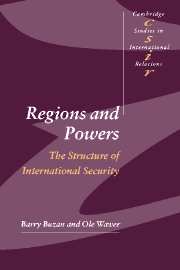Book contents
- Frontmatter
- Contents
- List of illustrations
- Preface
- List of abbreviations
- 1 Patterns of regional security during the Cold War
- 2 Patterns of regional security post-Cold War
- Part I Introduction: developing a regional approach to global security
- Part II Asia
- Part III The Middle East and Africa
- Part IV The Americas
- Part V The Europes
- Introduction
- 11 EU-Europe: the European Union and its ‘near abroad’
- 12 The Balkans and Turkey
- 13 The post-Soviet space: a regional security complex around Russia
- Conclusions: scenarios for the European supercomplex
- Part VI Conclusions
- Glossary
- References
- News media
- Index of names
- General Index
- CAMBRIDGE STUDIES IN INTERNATIONAL RELATIONS
13 - The post-Soviet space: a regional security complex around Russia
Published online by Cambridge University Press: 05 December 2009
- Frontmatter
- Contents
- List of illustrations
- Preface
- List of abbreviations
- 1 Patterns of regional security during the Cold War
- 2 Patterns of regional security post-Cold War
- Part I Introduction: developing a regional approach to global security
- Part II Asia
- Part III The Middle East and Africa
- Part IV The Americas
- Part V The Europes
- Introduction
- 11 EU-Europe: the European Union and its ‘near abroad’
- 12 The Balkans and Turkey
- 13 The post-Soviet space: a regional security complex around Russia
- Conclusions: scenarios for the European supercomplex
- Part VI Conclusions
- Glossary
- References
- News media
- Index of names
- General Index
- CAMBRIDGE STUDIES IN INTERNATIONAL RELATIONS
Summary
In most Western analyses of the area of the former Soviet Union, the situation is presented as anomalous due to the blatantly asymmetrical relations. The underlying agenda is how the weaker states around Russia can gain enough independence and equality to establish a more ‘normal’ relationship. However, as argued above, there is nothing historically (ch. 1) or theoretically (ch. 3) strange about regions with a dominant power at the centre. Analytically we should rather try to understand how this RSC operates and where it is placed and headed in the larger historical pattern. This particular region has historically been structured by two long-term patterns: (1) the waves of growth and contraction of the Russian Empire; (2) change in degrees of separateness and involvement with other regions, primarily Europe.
The chapter opens with a brief discussion of the historical trajectory of the Russian state as well as those of the new states that have significant state histories of their own. The main section examines security dynamics as they have evolved in the region from the dissolution of the Soviet Union to today, in terms of levels (domestic, regional, interregional, global). Within this it specifies the variation among four different subregions: the Baltic states, the western group of states, the Caucasus, and Central Asia. For most of the states, security concerns relate mainly to other states in the subcomplex plus Russia.
- Type
- Chapter
- Information
- Regions and PowersThe Structure of International Security, pp. 397 - 436Publisher: Cambridge University PressPrint publication year: 2003
- 1
- Cited by



